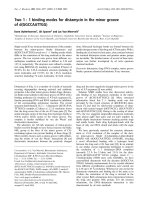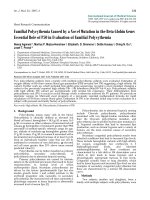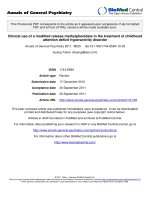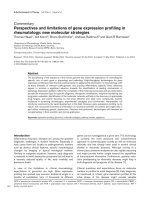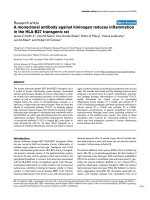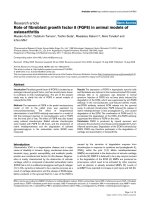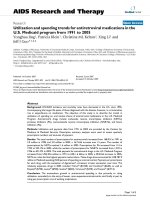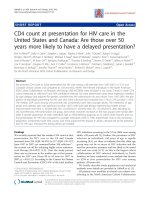Báo cáo y học: "Leukocyte oxygen radical production determines disease severity in the recurrent Guillain-Barré syndrome" doc
Bạn đang xem bản rút gọn của tài liệu. Xem và tải ngay bản đầy đủ của tài liệu tại đây (295.06 KB, 6 trang )
RESEARC H Open Access
Leukocyte oxygen radical production determines
disease severity in the recurrent Guillain-Barré
syndrome
Natalia Mossberg
1
, Oluf Andersen
1
, Magnus Nordin
1
, Staffan Nilsson
3
, Åke Svedhem
2
, Tomas Bergström
2
,
Kristoffer Hellstrand
2
, Charlotta Movitz
2*
Abstract
Background: The recurrent Guillain-Barré syndrome (RGBS) is characterized by at least two GBS episodes with
intervening remission. In a previous study of monophasic GBS, we reported that the magnitude of oxygen radical
production ("respiratory burst”) in peripheral blood leukocytes was inversely correlated to disease severity. The
present study sought to establish a similar correlation in patients with RGBS.
Methods: Oxygen radical production in leukocytes was induced by formyl-Met-Leu-Phe (fMLF), Trp-Lys-Tyr-Met-Val-
Met-NH
2
(WKYMVM), or phorbol myristate acetate (PMA) and assessed by quantifying superoxide anion formed by
the leukocyte NADPH oxidase.
Results: Disease severity, assessed using the MRC score, was negatively correlated to superoxide anion production
triggered by fMLF or WKYMVM (p = 0.001 and 0.002, respectively; n = 10). Superoxide anion production also was
significantly lower in RGBS patients wi th incomplete recovery after stimul ation with fMLF (p = 0.004) or WKYMVM
(p = 0.003).
Conclusion: We conclude that a lower respiratory burst in leukocytes is strongly associated with a severe course of
RGBS.
Introduction
The recurrent Guillain-Barré syndrome ( RGBS) is a
demyelinating disease of the peri pheral nervous system
characterized by episodes of relapsing and remitting
symptoms with complete or near complete functional
recover y between episodes [1-3]. Each episode fulfils the
diagnostic criteria for GBS including symmetric limb
weakness and decreased or absent muscle reflexes, or
Miller Fisher syndrome [4,5].
The respiratory burst in human phagocytes is a pivotal
anti-microbial effector f unction of the innate immune
defense [6]. The nicotina mide adenine dinucleotide
phosphate (NADPH) oxidase initiates the respiratory
burst by reducing o xygen in phagocytic cells to form
reactive oxygen species such as superoxide anions,
hydrogen peroxide, toxic halids, and hydroxyl radicals.
While it is well established that these toxic oxygen deri-
vatives participate in controlling b acterial and parasitic
infections, a deficiency in NADPH oxidase activity may
also be related to the development of autoimmunity. A
polymorphism in Ncf1, which encodes a cytosolic oxi-
dase component, c ompromises NADPH oxidase func-
tion and predispose s for a severe course of experimental
autoimmune encephalitis, a rthritis, and neuritis in
rodent models [7-9].
In patients with the monophasic form of GBS, a low
capacity of blood leukocytes to generate oxyg en radicals
in response to stimulation with NADPH oxidase-activat-
ing agents was recently found to correlate with a severe
course of disease [10]. A similar correlation has also
been found in mul tiple sclerosis [11]. The present study
was designed to determine a putative relationship
between the intensity of respira tory burst in leukocytes
and disease severity in patients with RGBS.
* Correspondence:
2
Department of Infectious Diseases, University of Gothenburg, Sweden
Full list of author information is available at the end of the article
Mossberg et al. Journal of Inflammation 2010, 7:40
/>© 2010 Mossberg et al; licensee BioMed Central Ltd. This is an Open Access article distributed under the terms of the Creative
Commons Attribution License ( g/licenses/by/2.0), which pe rmits unrestricted use, distribution, and
reproduction in any medium, provided the original work is properly cited.
Materials and methods
Trp-Lys-Tyr-Met-Val-Met-NH
2
(WKYMVM) was from
Alta Bioscience (University of Birmingham, United
Kingdom). N-formyl-Met-Leu-Phe (fMLF) and phorbol
myrist ate acetate (PMA) were from Sigma Chemical Co.
(St. Louis, Missouri). Horseradish peroxidase (HRP) was
from Boehringer-Mannheim (Mannheim, Germany).
Luminol and isoluminol were from Sigma Chemical Co.
Study subjects and diagnostic criteria
RGBS patients were included according to the following
definition: at least two episodes of relapsing symmetric
limb w eakn ess with decreased or absent muscle reflexes,
where each episode fulfilled the diagnostic criteria for GBS
with time from onset to peak neurological deficit (time to
nadir) of four weeks or less [4,5]. The recovery after each
relapseshouldbecompleteornearcomplete[3],witha
minimum of at least two months between relapses [12].
Patients with treatment related fluctuat ions [13] and
patients with the recurrent form of chronic inflammatory
demyelinating polyneuropathy (CIDP), in whom time to
nadir is more than 2 months, were excluded [14].
Ten consecutive RGBS patients (nine males and one
woman, aged 43) in remission and without immunomo-
dulatory therapy, admitted to Sahlgrenska University
Hospital during relapses, were included for follow-up
examination. All patients had been treated during attacks
with intravenous immunoglobuline or plasma exchange,
and two patients had previously rec eived prophylactic
immunosuppressive therapy. Healthy controls were the
patients’ spouses ( n = 5) or age-matched subject s (n = 5;
mean age 52, range 33-69 years). The study was approved
by the Medical Ethics Committee and written informed
consent was obtained from all participants.
Clinical examination and retrospective evaluation
A neurological f ollow-up examination was performed
with scoring according to Medical Research Council
sumscore(MRC)[15],andthedegreeofremission
(complete or incomplete) was recorded for the second
and last attack. MRC score of 60 (maximum in healthy
persons) is defined as a complete recovery. At follow-up
the patients were free from relapse. Nine patients had
not received immunomodulatory treatment for at least
one month before examination and blood sampling, and
one patient (with a history of ulcerative colitis) had
received low dose cortisone (10 mg/day) until 1 week
prior to blood sampling. The median time from the last
relapse to examination and sampling was 7 months
(range 1 month-12 years). Information of antecedent
events, number of episodes and interval between epi-
sodes, time to second episode, age a t first and last epi-
sode, duration of the plateau phase, episode duration,
and the degree of remission for each episode were
obtained from medical records. Neurophysiological fol-
low-up examination including nerve conduction study
was performed according to routine methods used at
the Department of Clinical Neurophysiology at Sahl-
grenska University Hospital.
Leukocyte isolation
Peripheral leukocytes (neutrophils, monocytes, and lym-
phocytes) were isolated from hepari nized venous blood
by dextran sedimentation and hypotonic lysis of remain-
ing e rythrocytes as described elsewhere [16,17]. Leuko-
cytes were resuspended (10
7
cells/ml) in Krebs-Ringer
buffer (KRG) [18]. No significant differences in leuko-
cyte counts or distribution were detected between
patients and controls or between groups of patients with
different severity of RGBS (data n ot shown). Sorting
experiments revealed that > 99% of the oxygen radical
production in peripheral blood leukocytes was contribu-
ted by phagocytic cells, i.e. monocytes and neutrophilic
granulocytes (data not shown).
NADPH oxidase activity
Leukocyte production of superoxide anion, which is the
initial oxygen radical formed by the NADPH oxidase
[18], was assessed in duplicate using isoluminol/lumi-
nol-enhanced chemiluminescence (CL) technique [19].
The CL was measured in a Biolumat LB 9505 (Berthol d
Co., Wildbad, Germany), using a 1 ml reaction mixture
containing 10
6
leukocytes, h orseradish peroxidase (4 U/
ml), and isoluminol or luminol (20 μM). The cells were
activated by 10
-7
MfMLF,10
-7
MWKYMVMor5×
10
-8
M PMA.
Myeloperoxidase activity
Myeloperoxidase (MPO), a leukocyte enzyme, forms
hypochlorous acid from H
2
O
2
which results in the pro-
duction of toxic halides and the hydroxyl radical [20].
MPO activity was assessed in leukocytes (KRG, 10
7
cells/ml) and measured spectrophotometrically as the
oxidation of 4-aminoantipyrine in the presence of
hydrogen peroxide and MPO [17]. Volumes o f 430 μl
2.5 mM 4-aminoantipyrine and 500 μl1.7mMH
2
O
2
were added to cuvettes. After e quilibration for 4 min at
room temperature, 100 μl sonicated cells (2 × 10
6
cells/
ml), pre-incubated with 0.1% Triton X-100, were added.
The change in absorbance was measured at 510 nm for
4 min (Perkin Elmer lambda 2) in duplicate and the
mean value was used for statistical analysis.
Microbiological analyses
A standardized set of serological analyses for diagnosis
of viral and bacterial infections were performed at the
Mossberg et al. Journal of Inflammation 2010, 7:40
/>Page 2 of 6
Department of Virology, Sah lgrenska University Hospi-
tal. Serum IgG and IgM analyses for cytomegalovirus
(CMV), Epstein-Barr virus (EBV), herpes simplex virus
(HSV), varicella zoster virus (VZV), mumps, measles,
rubella, enterovirus, influenza A and B, parainfluenza,
respiratory syncytial virus (RSV), adenovirus and Myco-
plasma pneumoniae were performed in the acute and
convalescent phases of se veral RGBS attacks. The fol-
lowing methods were used: enzyme-linked i mmunosor-
bent assay (ELISA) for IgG and immunofluorescence
(IF) assay of IgM antibodies against HSV (type 1 and 2),
VZV and CMV; by IF assay of IgG and IgM antibodies
against EBV, mumps, measles, and Toxoplasma gondii;
by ELISA of IgM for enteroviruses, rubella, RSV and
Mycoplasma pneumoniae; and by complement fixation
(CF) assay of antibodies against influenza A and B. Cri-
teria for positive diagnosis o f these infections were
either at least a four-fold titre-rise between paired sam-
ples (IgG and CF) or positive IgM at more than four-
fold dilutions over negative controls. The assay of Cam-
pylobacter jejuni infection was based on a DIG-ELISA
utilising an outer membrane glycoprotein. Criteria for
diagnosis were positive IgM or IgA titres or a significant
rise of consecutive IgG titres [21].
Statistics
Superoxide anion production and MPO activity were
analyzed as response variables with a linear model
using RGBS severity groups as predictors with a one-
sided research hypothesis based on previous findings
for GBS. The measurement day was used as a nuisance
factor to adjust for experimental day-to-day variation.
A paired test was used between patients and controls.
For numeric severity variables the relationship to
superoxide anion production was analyzed by one-
sided Pearson (r) or Spearman (r
s
) correlation. The
logarithm of the time to the second bout was used in
correlation analysis.
Results
Clinical data
Themediantimebetweenthefirstattackandfollow-
up was 15 years (0.5-40 years). A total of 38 attacks
occurred in these patients (median 3 per patient,
range 2-7) (Table 1). Five patients had complete
recovery and 5 patients had motor residual deficit at
follow-up.
Preceding infections in relation to relapse
Several relapses were p receded by an infectious illness,
most commonly by an u pper respiratory tract inf ection
(present in 8 patients) or a Campylobacter infection
(present in 5 patients and detected in 13 of 22 episodes)
(Table 1).
Correlation between clinical aspects of RGBS and
respiratory burst
The superoxide anion production after stimulation with
fMLF and WKYMVM was significantly lower in RGBS
patients with incomplete than complete recovery after
the second attack (p = 0.0035 for both peptides) and at
follow-up (p = 0.004 and p = 0.003; Table 2 and Fig. 1).
Superoxide anion produ ction was correlated with MRC
score at follow-up when induced by fMLF (r
s
=0.85,
p = 0.001) and by WKYMVM (r
s
= 0.82, p = 0.002).
Table 1 RGBS patient characteristics
Clinical data RGBS patients, n = 10
Mean number episodes per patient 3
(2-7)
Follow-up time since first episode 15 years
(0.5-40 years)
Mean age at follow-up 52 years
(33-73 years)
Mean age first episode 35.7 years
(21-52 years)
Respiratory care 3 patients,
7 episodes
Preceding infection
at relapse
URTI 8 patients,
22 episodes
Campylobacter jejuni 5 patients,
13 of 22 episodes*
CMV 3 patients,
4 of 5 episodes*
RSV 1 patient,
3 of 4 episodes*
Influenza A 1 patient,
1 of 3 episodes*
VZV reactivation 1 patient,
1 of 4 episodes*
URTI- upper respiratory tract infection
* Number of episodes with a positive virus- or Campylobacter
serology per number of episodes with adequate (according to section
Microbiological analyses) sampling and analysis.
Only positive findings were included in this table.
Table 2 Superoxide anion production in leukocytes
isolated from RGBS patients with incomplete and
complete recovery at follow- up
O
2
-
production (Mcpm)
stimuli - recovery + recovery p value
fMLF 47 ± 23 170 ± 25 0.004
WKYMVM 54 ± 20 166 ± 21 0.003
PMA 488 ± 35 576 ± 38 0.08
Leukocytes isolated from RGBS subjects were triggered with fMLF (10
-7
M),
WKYMVM (10
-7
M) or PMA (5 × 10
-8
M). The release of superoxide anions was
measured by isoluminol/luminol-enhanced CL. Data are presented as marginal
mean peak values ± SEM comparing O
2
-
production between patients with
incomplete (-) and complete (+) recovery using a one-sided test in a linear
model.
Mossberg et al. Journal of Inflammation 2010, 7:40
/>Page 3 of 6
Lower superoxide anion production after stimulation
with fMLF and WKYMVM was associated with a longer
plateau phase during relapse (r = -0.59, p = 0.037 and
r = -0.58, p = 0.04), a shorter median interval between
relapses (r = 0.68, p = 0.016 and r = 0.76, p = 0.006),
and a shorter interval to the second attack (r = 0.58, p =
0.039 and r = 0.66, p = 0.02). There was no significant
difference in superoxide anion production between
RGBS patients and their age-matched controls, for
whom the superoxide anion production was intermedi-
ate between patients with complete and incomplete
recovery(p=0.09forfMLF,p=0.19forWKYMVM
and p = 0.23 for PMA).
A lower supe roxide anion production after stimulation
with fMLF and WKYMVM was associated with a longer
distal motor latency (r
s
= -0.74, p = 0.007 and r
s
=-0.69
and p = 0.015), a lower motor nerve conduction velocity
(r
s
= 0 .59, p = 0.037 for both peptides ), an d a lower amplitude
(r
s
= 0.58, p = 0.037 and r
s
= 0.69, p = 0.013) at follow-up.
MPO activity
MPO activ ity in leukocytes di d not differ betwe en
patients and controls (p = 0.63) or between severity
groups of RGBS patients with co mplete or incomplete
recovery (p = 0.57) (data not shown).
Discussion
A main finding in this study was that superoxide anion
production by leukocytes in response to NA DPH oxi-
dase-activa ting peptides was associated wit h severity of
disease in patients with RGBS. Thus, the superoxide
anion response to fMLF and WKYMVM was signifi-
cantly lower in RGBS patients with incomplete recovery,
higher residual motor deficit, and longer duration of the
plateau phase during attacks. We also observed a signifi-
cant association between the individual attack frequency
(shorter interval between relapses including the time
from the onset to the second relapse) and respiratory
burst, indicating a h igher tendency for the disease to
recur in patients with low superoxide anion production.
The peptides fMLF and WKYMVM activates NADPH
oxidase via formyl peptide receptors (FPRs), which are
transmembrane G-protein coupled receptors present in
monocytes and neutrophils. fMLF interacts with FPR1,
whereas WKYMVM binds to FPR2 and FPR3 [22].
Notably, the severity of RGBS was unrelated to the oxygen
radical production in response to PMA, a membrane-
permeable proteine kinase C (PKC) activator [23]. PKC is
located downstream of FPR1, FPR2 and FPR3 and
upstream of the NADPH oxidase, and thus activates the
oxidase independently of FPRs. Since no difference in
MPO activity was detected, the difference in radical pro-
duction is not dependent on the H
2
O
2
(produced by the
NADPH oxidase) consuming MP O-H
2
O
2
-halide system.
Our findings therefore suggest that the overall function of
the oxidase is intact in patients with severe RGBS, and that
the reduced responsiveness to NADPH oxidase inducers in
patients with severe RGBS is located u pstream of PKC.
These findings imply that the capacity of leukocytes to
mount a respi ratory burst is of relevance to the severity
of autoimmunity, as previously shown in monophasic
GBS and in MS [10,11]. In t his regard GBS, RGBS and
MS mirror previous studies in rodents, in which a defi-
cient NADPH oxidase was associated with severity of
experimental autoimmunity [7-9]. The mechanisms
underlying the association between low oxygen radical
production and severe symptoms of autoimmunity dis-
ease are not known. In accordance with previous studies
[1], we found a high incidence of infections prior to
onset of RGBS, and it may be speculated that a reduced
oxygen radical production results in a less efficacious
microbial clearance. An alternative or supplementary
mechanism relates to the regulatory effects of oxygen
radicals on T cells and other subsets of lymphocytes.
Phagocyte-derived oxygen radicals efficiently trigger
apoptosis in CD4
+
and CD8
+
T cells [24,25], and it is
conceivable that a deficient elimination of autoreactive
T cells by oxygen radicals may aggravate autoimmune
manifestations [26].
Figure 1 Production of superoxide anion in leukocytes isolated
from RGBS patients in relation to complete and incomplete
remission. Leukocytes isolated from RGBS patients were stimulated
by 10
-7
M fMLF. The production of superoxide anion was measured
kinetically by isoluminol or luminol-amplified chemiluminescence.
Responses are given as Mcpm (10
6
counts per minute), presented
as the mean CL values ± SEM at different time points. The statistical
significance of difference in superoxide anion production between
subjects with complete (solid line) and incomplete recovery (dashed
line) was determined using two-tailed, unpaired Student’s t-test, p <
0.01**, p < 0.001***.
Mossberg et al. Journal of Inflammation 2010, 7:40
/>Page 4 of 6
Oxygen radicals are traditionally b elieved to promote
damage of tissue in several diseases including athero-
sclerosis, reperfusion injury, and emphysema [6]. ROS
produced locally in CNS function as a mediator of
demyelination and axonal injury, both in experimental
autoimmune encephalomyelitis and MS [27,28]. How-
ever, there is increas ing evidence for a protective role of
innate immunity in autoimmune disease [29] in which
oxygen radicals dampen the development of autoim-
mune disorders (reviewed in [30]). This is shown in
Crohn’ s disease where a defect neutrophil function,
including migration, chemotaxis, supeoxide anion pro-
duction, and phagocytosis has been described [31]. The
effects of a deficient oxygen radical production in
chronic granulomatous disease(CGD)areinteresting.
CGD is caused by an inability of the NADPH oxidase to
produce oxygen r adicals and is characterized by recur-
rent infections, sterile granuloma but is also associated
with autoimmune diseases [32,33]. In a recent study,
CGD monocytes were shown to produce significantly
higher levels of cytokines than control cells [34] which
could explain the association with autoimmunity. It is
thus important to discriminate between oxyg en radicals
and oxidative stress. The latest is a process of harmful
massive production of oxygen radical with tissue
destructive properties. On the o ther hand, oxygen radi-
cals produced at the right time and place and with strict
(redox) regulation may have a beneficial regulatory
potential, playing a crucial role in the innate immune
defence [35].
Conclusion
In conclusion, we propose that the capacity of leuko-
cytes to generate oxygen radicals in response to
NADPH oxidase-triggering peptides is related to the
severity of RGBS. The mechanistic a spects of this asso-
ciation should be the subject of further study, along
with studies outlining the role of leukocyte-derived
oxygen radical for other autoimmune diseases.
Acknowledgements
This work was supported by grants from the Research Foundation of The
Gothenburg Multiple Sclerosis Society, The Swedish Medical Research
Council, The Swedish Association of Persons with Neurological Disabilities,
The Inga-Britt and Arne Lundberg Research Foundation, The Torsten and
Ragnar Söderberg Foundation, The Anna-Lisa and Bror Björnsson
Foundation, and The Åke Wiberg Foundation.
Author details
1
Department of Neuroscience and Physiology, University of Gothenburg,
Sweden.
2
Department of Infectious Diseases, University of Gothenburg,
Sweden.
3
Department of Mathematical Statistics, Chalmers University of
Technology, Gothenburg, Sweden.
Authors’ contributions
NM, CM, OA, KH and TB participated in the conception and design of the
study. NM and CM carried out the measurements of oxygen radical
production. CM performed MPO activity measurements. NM and OA
performed the clinical examination and retrospective evaluation. MN
performed the neurophysiological follow-up examinat ion. TB and ÅS
participated in the microbiological analyses. SN and NM performed the
statistical analysis. KH, CM, MN and OA drafted the manuscript. All authors
read and approved the final manuscript.
Competing interests
The authors declare that they have no competing interests.
Received: 9 March 2010 Accepted: 8 August 2010
Published: 8 August 2010
References
1. Grand’Maison F, Feasby TE, Hahn AF, Koopman WJ: Recurrent Guillain-
Barre syndrome. Clinical and laboratory features. Brain 1992, 115(Pt
4):1093-1106.
2. Roper TA, Alani SM: Recurrent Guillain-Barre syndrome: lightning does
strike twice. Br J Hosp Med 1995, 53:403-407.
3. Das A, Kalita J, Misra UK: Recurrent Guillain Barre’ syndrome. Electromyogr
Clin Neurophysiol 2004, 44:95-102.
4. Asbury AK, Cornblath DR: Assessment of current diagnostic criteria for
Guillain-Barre syndrome. Ann Neurol 1990, 27(Suppl):S21-24.
5. Van der Meche FG, Van Doorn PA, Meulstee J, Jennekens FG: Diagnostic
and classification criteria for the Guillain-Barre syndrome. Eur Neurol
2001, 45:133-139.
6. Babior BM: Phagocytes and oxidative stress. Am J Med 2000, 109:33-44.
7. Olofsson P, Holmberg J, Tordsson J, Lu S, Akerstrom B, Holmdahl R:
Positional identification of Ncf1 as a gene that regulates arthritis
severity in rats. Nat Genet 2003, 33:25-32.
8. Hultqvist M, Olofsson P, Holmberg J, Backstrom BT, Tordsson J, Holmdahl R:
Enhanced autoimmunity, arthritis, and encephalomyelitis in mice with a
reduced oxidative burst due to a mutation in the Ncf1 gene. Proc Natl
Acad Sci USA 2004, 101:12646-12651.
9. Huberle A, Beyeen AD, Ockinger J, Ayturan M, Jagodic M, de Graaf KL,
Fissolo N, Marta M, Olofsson P, Hultqvist M, et al: Advanced intercross line
mapping suggests that ncf1 (ean6) regulates severity in an animal
model of guillain-barre syndrome. J Immunol 2009, 182:4432-4438.
10. Mossberg N, Andersen O, Nilsson S, Dahlgren C, Hellstrand K, Lindh M,
Svedhem A, Bergstrom T, Movitz C: Oxygen radical production and
severity of the Guillain–Barre syndrome. J Neuroimmunol 2007,
192:186-191.
11. Mossberg N, Movitz C, Hellstrand K, Bergstrom T, Nilsson S, Andersen O:
Oxygen radical production in leukocytes and disease severity in multiple
sclerosis. J Neuroimmunol 2009, 213:131-134.
12. Kuitwaard K, van Koningsveld R, Ruts L, Jacobs BC, van Doorn PA:
Recurrent Guillain-Barre syndrome. J Neurol Neurosurg Psychiatry 2009,
80:56-59.
13. Ruts L, van Koningsveld R, van Doorn PA: Distinguishing acute-onset CIDP
from Guillain-Barre syndrome with treatment related fluctuations.
Neurology 2005, 65:138-140.
14. Hughes RA, Bouche P, Cornblath DR, Evers E, Hadden RD, Hahn A, Illa I,
Koski CL, Leger JM, Nobile-Orazio E, et al
: European Federation of
Neurological Societies/Peripheral Nerve Society guideline on
management of chronic inflammatory demyelinating
polyradiculoneuropathy: report of a joint task force of the European
Federation of Neurological Societies and the Peripheral Nerve Society.
Eur J Neurol 2006, 13:326-332.
15. Kleyweg RP, van der Meche FG, Schmitz PI: Interobserver agreement in
the assessment of muscle strength and functional abilities in Guillain-
Barre syndrome. Muscle Nerve 1991, 14:1103-1109.
16. Boyum A: Isolation of mononuclear cells and granulocytes from human
blood. Isolation of monuclear cells by one centrifugation, and of
granulocytes by combining centrifugation and sedimentation at 1 g.
Scand J Clin Lab Invest Suppl 1968, 97:77-89.
17. Metcalf JA, Gallin JI, Nauseef WM, K Root R: Laboratory Manual of Neutrophil
Function 1986.
18. Dahlgren C, Karlsson A: Respiratory burst in human neutrophils. J
Immunol Methods 1999, 232:3-14.
Mossberg et al. Journal of Inflammation 2010, 7:40
/>Page 5 of 6
19. Lundqvist H, Dahlgren C: Isoluminol-enhanced chemiluminescence: a
sensitive method to study the release of superoxide anion from human
neutrophils. Free Radic Biol Med 1996, 20:785-792.
20. Klebanoff SJ: Myeloperoxidase: friend and foe. J Leukoc Biol 2005,
77:598-625.
21. Svedhem A, Gunnarsson H, Kaijser B: Diffusion-in-gel enzyme-linked
immunosorbent assay for routine detection of IgG and IgM antibodies
to Campylobacter jejuni. J Infect Dis 1983, 148:82-92.
22. Ye RD, Boulay F, Wang JM, Dahlgren C, Gerard C, Parmentier M, Serhan CN,
Murphy PM: International Union of Basic and Clinical Pharmacology.
LXXIII. Nomenclature for the formyl peptide receptor (FPR) family.
Pharmacol Rev 2009, 61:119-161.
23. Wolfson M, McPhail LC, Nasrallah VN, Snyderman R: Phorbol myristate
acetate mediates redistribution of protein kinase C in human
neutrophils: potential role in the activation of the respiratory burst
enzyme. J Immunol 1985, 135:2057-2062.
24. Jackson SH, Devadas S, Kwon J, Pinto LA, Williams MS: T cells express a
phagocyte-type NADPH oxidase that is activated after T cell receptor
stimulation. Nat Immunol 2004, 5:818-827.
25. Hansson M, Asea A, Ersson U, Hermodsson S, Hellstrand K: Induction of
apoptosis in NK cells by monocyte-derived reactive oxygen metabolites.
J Immunol 1996, 156:42-47.
26. Hultqvist M, Backlund J, Bauer K, Gelderman KA, Holmdahl R: Lack of
reactive oxygen species breaks T cell tolerance to collagen type II and
allows development of arthritis in mice. J Immunol 2007, 179:1431-1437.
27. Gilgun-Sherki Y, Melamed E, Offen D: The role of oxidative stress in the
pathogenesis of multiple sclerosis: the need for effective antioxidant
therapy. J Neurol 2004, 251:261-268.
28. Minohara M, Matsuoka T, Li W, Osoegawa M, Ishizu T, Ohyagi Y, Kira J:
Upregulation of myeloperoxidase in patients with opticospinal multiple
sclerosis: positive correlation with disease severity. J Neuroimmunol 2006,
178:156-160.
29. Etzioni A: Immune deficiency and autoimmunity. Autoimmun Rev 2003,
2:364-369.
30. Hultqvist M, Olsson LM, Gelderman KA, Holmdahl R: The protective role of
ROS in autoimmune disease. Trends Immunol 2009, 30:201-208.
31. Korzenik JR, Dieckgraefe BK: Is Crohn’s disease an immunodeficiency? A
hypothesis suggesting possible early events in the pathogenesis of
Crohn’s disease. Dig Dis Sci 2000, 45:1121-1129.
32. Segal BH, Leto TL, Gallin JI, Malech HL, Holland SM: Genetic, biochemical,
and clinical features of chronic granulomatous disease. Medicine
(Baltimore)
2000, 79:170-200.
33. De Ravin SS, Naumann N, Cowen EW, Friend J, Hilligoss D, Marquesen M,
Balow JE, Barron KS, Turner ML, Gallin JI, Malech HL: Chronic
granulomatous disease as a risk factor for autoimmune disease. J Allergy
Clin Immunol 2008, 122:1097-1103.
34. Brown KL, Bylund J, MacDonald KL, Song-Zhao GX, Elliott MR, Falsafi R,
Hancock RE, Speert DP: ROS-deficient monocytes have aberrant gene
expression that correlates with inflammatory disorders of chronic
granulomatous disease. Clin Immunol 2008, 129:90-102.
35. Gelderman KA, Hultqvist M, Olsson LM, Bauer K, Pizzolla A, Olofsson P,
Holmdahl R: Rheumatoid arthritis: the role of reactive oxygen species in
disease development and therapeutic strategies. Antioxid Redox Signal
2007, 9:1541-1567.
doi:10.1186/1476-9255-7-40
Cite this article as: Mossberg et al.: Leukocyte oxygen radical
production determines disease severity in the recurrent Guillain-Barré
syndrome. Journal of Inflammation 2010 7:40.
Submit your next manuscript to BioMed Central
and take full advantage of:
• Convenient online submission
• Thorough peer review
• No space constraints or color figure charges
• Immediate publication on acceptance
• Inclusion in PubMed, CAS, Scopus and Google Scholar
• Research which is freely available for redistribution
Submit your manuscript at
www.biomedcentral.com/submit
Mossberg et al. Journal of Inflammation 2010, 7:40
/>Page 6 of 6
